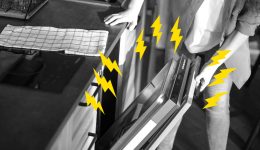New Online Options Available Now Learn More

Preparing Your Roof For Monsoon Season
Getting your roof in shape now will give you peace of mind knowing that when the monsoons hit later your home and belongings will stay dry. By following a few steps you can easily determine the condition of your roof. You should start with inspecting it to make sure it is in good enough condition to move all that rain water away from your house. You can also do most of the minor repairs at the weak spots you find before the water can do any more damage.
Start by inspecting the roof from the outside. You may need a sturdy ladder that’s tall enough so you can see every part of the roof or be able to climb up onto it. Look for any roofing material that’s come loose. You may want to carry a hammer and the other materials needed so you can replace loose or missing shingles or tiles as you find them. Wood shake style shingles can be very slippery when wet so be very careful walking on this type of roof. You will want to check for corrosion or rust if you have a metal roof. No matter what type of roofing material you have, if there are slopes check the valleys where water or debris can accumulate and cause mold or rot. There are also often flashings in these areas, which are metal pieces used to deflect the flow of water. You will want to check to make sure any of them are still securely held in place.
After finishing inspecting the top of the roof you may want to walk around the parameter of your home and visually inspect the gutters. They should be securely fastened to the house. The downspouts need to be facing outwards so that the water will be diverted away from your foundation. While walking around your home you can also inspect any eaves or overhangs to make sure they do not show any signs of water damage. If there are water spots on them you may want to double check that section of roofing material to find the problem.
You may want to go inside your home next to check the ceilings for any signs of water damage. They are easy to spot because your ceiling or drywall will be discolored. A flashlight may come in handy when there’s not a lot of light. You can use the flashlight too when inspecting the attic if you have one. Safety is extremely important when trying to navigate around all of the beams and rafters. You should look for any problem spots or rotted wood where you can see that water has leaked inside your home. Any insulation material near a leak may still be wet. You can also check for leaks by turning off your flashlight and looking for any places where you can see the sunlight coming in from outside. If you can see the sunlight coming in from outside that means there’s a hole there that needs to be fixed. If you have any questions about any repairs you may want to talk to a roofing professional to avoid doing anything incorrectly.
Once you have completely inspected your home and fixed any minor repairs you may want to check your current homeowner’s insurance policy to see if have roof leak coverage. Many policies cover damage from hail, lightning and other types of storms. But you may need to get a separate coverage to protect yourself from expensive leak damage. If you do not already have it you may want to talk to an insurance agent. Extensive water damage can be costly and it may require you to have an entirely new roof installed, as well as replacing damaged support beams and drywall inside your home. Roof leak insurance may be an affordable and cost effective way of protecting your home.
 Click Here To Call Us
Click Here To Call Us

 By Platinum Team
By Platinum Team 





